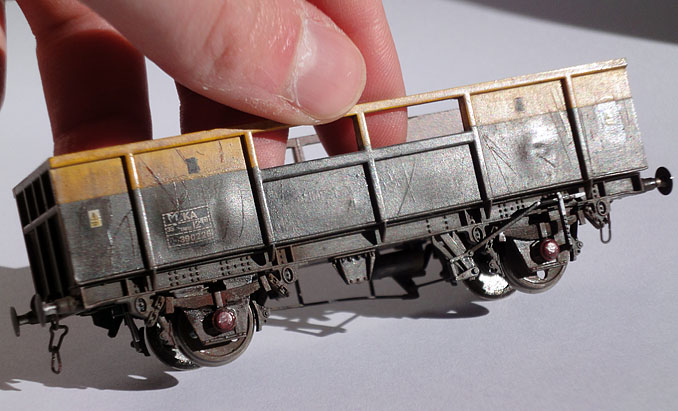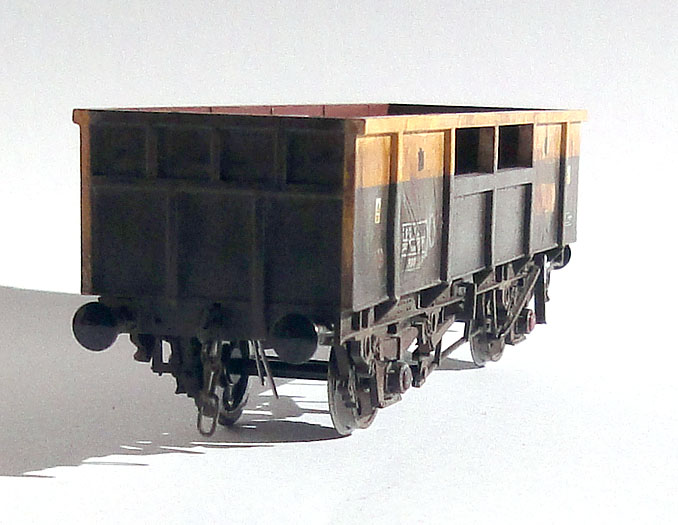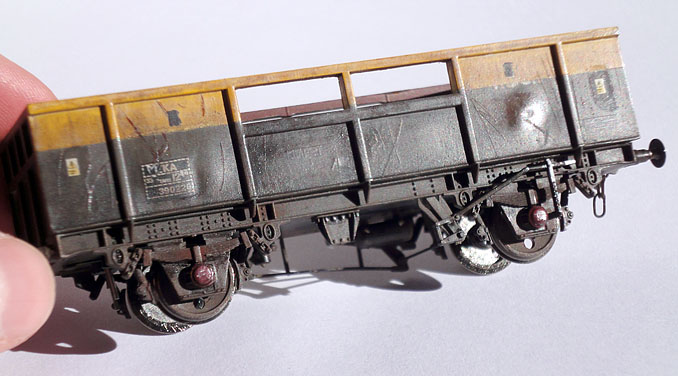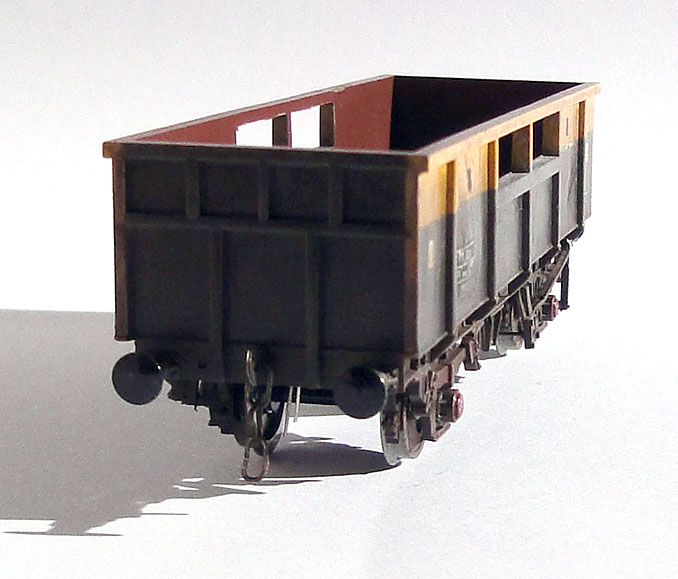As requested, here are some pictures of the dents in my limpet and a spiel on how I did it.

(Please forgive the image quality - I can't find the charger for my SLR battery so these are taken with a Sony digicam. It's a nice camera for a lot of purposes (fast, accurate colour, decent metering) but it seems to have a lot of problems with macro focus and general softness, especially at the telephoto end. Oh well.)
I wanted to try some denting since lots of real MKA/ZKA wagons have dented (bowed out) lower body panels, presumably as a result of unloading. Most of the model denting I've seen involves softening the bars at the top of the frame, but that doesn't seem common in real life - the bars are box section so they're likely a lot stronger than the panels. Denting the panels is tricky because the Bachmann body is pretty thick - this is probably a good compromise on their part since it stops the sides bowing in and isn't that obvious thanks to the box section frame around the top edge, but it made my life quite difficult!
I tried using a soldering iron held near the inside, but while it will create nice gouges, it's too localised to soften an entire panel and bow it out. I had a go with a bit of sheet brass as a heat spreader but it didn't really help. I didn't pursue this - I should have tried with a 40W iron instead of a 20W really, but instead went for the halogen work light I was using since it was nearby. I should add that I did some tests on a Hornby railroad mineral wagon which was a similar size and shape first (and only the centre section of that, since I'd already cut the ends down to make a narrow gauge tub for another project (throw nothing away!) The halogen light was warm enough to do the job, and the heat was spread over a wide area. There's a very fine line between "not long enough" and "too long" in terms of when to take the model away from the bulb and try forming it - in my case it was the difference between about 10 seconds and 10.5 seconds.
To make the dents, I removed the body from the underframe and held it to the light (avoiding touching the glass cover!) at an angle so the base of the body was nearer - this was to try and convince the panels to soften at the bottom and not the top. As you can see in the picture I managed to bend one of the bars inward, which I'd really wanted to avoid - possibly because the bars are proud of the body they tend to soften first and are then very delicate.

I got on better using a panel-sized mask cut from a postcard. I held this over the model to expose one panel at a time, which made the heating take longer and the bending more difficult, but kept the body and framing the right shape.

To be honest I'm not sure I'd bother doing this again with a limpet - maybe once more to confirm my suspicions? I know this is going to make me sound lazy but it seems like a lot of difficult nerve-wracking work for small reward. I had a lot of trouble photographing the results in daylight, although I can imagine that a couple of dented wagons at the start of a rake would make a nice photograph with low afternoon or evening light along the body sides. I guess looking for that was what got me to try in the first place. And if I had a suitable cheap wagon with a thinner body moulding I'd be more inclined to have another try.
Good things:
- The dents are mostly in the right direction and look believable.
- The bars are mostly intact.
- The factory paint and markings coped fine.
- The scratches I added afterwards were quite successful.
- I didn't end up with a pile of melted goo.
Bad things:
- Hard work - requires good timing, vigorous pressure (I used my thumb and a dental tool) and very quick work before the plastic firms up again.
- I distorted a couple of panels slightly too far up the body and ended up with a wavy edge on the yellow stripe. I touched this in with a brush and it's not too apparent under the weathering.
- I needed to fill in some soldering iron dents on the inside.
- The small panels don't dent as much as the large ones - there's more plastic closer to the frame so it doesn't move as easily - which looks a bit unrealistic given that they're cut down from large panels.

Has anyone else tried this, and if so how did you get on?



1 Comment
Recommended Comments
Create an account or sign in to comment
You need to be a member in order to leave a comment
Create an account
Sign up for a new account in our community. It's easy!
Register a new accountSign in
Already have an account? Sign in here.
Sign In Now